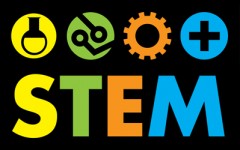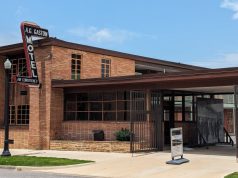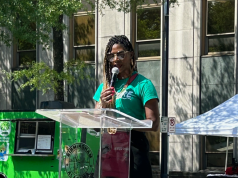 (NAPSA) – Recently, a program that helps put young people on a path to careers in science put one young man on a path that led to the White House.
(NAPSA) – Recently, a program that helps put young people on a path to careers in science put one young man on a path that led to the White House.
Several weeks ago, Eddie Cuba, 11, met President Obama at the White House Science Fair in a once-in-a-lifetime opportunity as one of the million kids who have been inspired by STEM (Science, Technology, Engineering, Mathematics) through Time Warner Cable’s Connect a Million Minds (CAMM) initiative.
Thanks to this initiative, Eddie had the opportunity to join a new program at Boys & Girls Club of Paterson & Passaic called Do-It-Yourself (DIY) STEM because he really enjoys learning science in a different environment after school, making rockets and light bulbs with friends. Since Eddie started the DIY STEM program, his grades have improved, and he wants to go to college and keep studying science because he thinks STEM is fun.
Future Job Outlook
Like many young people, Eddie came alive and was inspired by STEM when given the right opportunity for expanded learning outside the school day. STEM education is critical to the future success of our young people as most of the fastest-growing jobs will require some education in science, technology, engineering and math.
According to the Bureau of Labor Statistics, there will be 9.2 million jobs in STEM fields by 2020. Young people entering the workforce need more skills than they did decades ago – the ability to think critically and problem solve, leverage quantitative information and develop creative solutions both in teams and as individuals.
A Shortage Of Students
Unfortunately, there is a shortage of both interested and adequately prepared K-12 students in STEM subjects, especially among minority youth and young women. Gaps in science and math educational achievement for African American, Latino and Native American students start as early as the fourth grade.
Additionally, despite a steady increase over the past 20 years, only 15 percent of female high school students express an interest in STEM fields, as compared to 40 percent of male high school students. The opportunity gap in STEM education is likely to widen unless organizations develop pathways for more underrepresented youth to succeed in STEM careers.
Preparing For 21st Century Success
Parents, employers and educators are asking how best to prepare America’s young people, particularly underrepresented youth, for a successful post-secondary education and a 21st century career?
One way that shows promise is through out-of-school time. “The out-of-school environment – after school and summer – plays a critical and often overlooked role in helping young people develop needed skills and competencies,” says Damon A. Williams, Ph.D., senior vice president and chief education and youth development officer, Boys & Girls Clubs of America. “Out-of-school providers like Boys & Girls Clubs have an opportunity and responsibility to help more young people develop a passion and an aptitude in STEM-as many kids mistake a lack of foundational knowledge for a lack of talent or ability.”
Hands-On Learning
By introducing youth to hands-on, discovery-based STEM learning opportunities, out-of-school providers are teaching kids how to make technology through design thinking – rather than just consuming technology. This education is invaluable because there is a skills divide between young people who simply consume data as entertainment and kids who can apply data analytically and creatively.
Research shows that the out-of-school environment advances STEM learning and increases interest in STEM-related careers, particularly among underrepresented youth. In fact, African American, Asian American and Latino households are most likely to participate in out-of-school STEM programs.
As a complement to the school day, out-of-school programs also provide opportunities for trial-and-error beyond the school environment-a safe place to fail-while teaching critical 21st century skills like problem solving and perseverance, which are needed in STEM careers.
Partners Supporting STEM
For example, Boys & Girls Clubs of America recently partnered with Time Warner Cable to help address America’s declining proficiency in STEM by, together, launching the DIY STEM program during out-of-school time at Clubs across the country. Aligned with Time Warner Cable’s commitment to connect young people to the wonders of STEM, this curriculum engages Club youth ages 10 to 18 in the “science of every day,” focusing on energy and electricity, engineering design, and food chemistry, to provide out-of-school opportunities for critical thinking and peer exchange.
Out-of-school programs such as DIY STEM are often the first time underrepresented youth are given the opportunity to learn STEM in fun and motivating ways. These programs provide project-based learning opportunities that address real-world challenges and encourage innovative solutions, and these experiences can be life changing. According to Eddie, “I truly believe that learning science will help kids change the world.”
The Importance Of STEM
“Few issues are more important to the future of our nation as STEM education. Through strategic partnerships, I hope that more out-of-school STEM programs will be offered to underrepresented youth as a supplement to school, so they develop the skills and knowledge necessary to succeed in the 21st century workplace,” Williams says.
To learn more about this DIY STEM program, or to download the self-guided STEM activities, visit www.myclubmylife.com/diystem. To learn more about Time Warner Cable’s commitment to STEM, visit connectamillionminds.com.
Club youth Eddie Cuba and Jayda Collazo had the opportunity to attend the White House Science Fair with Time Warner Cable Chairman and CEO Rob Marcus.
Experts say the out-of-school environment plays a critical and often overlooked role in helping young people develop needed STEM skills and competencies.



